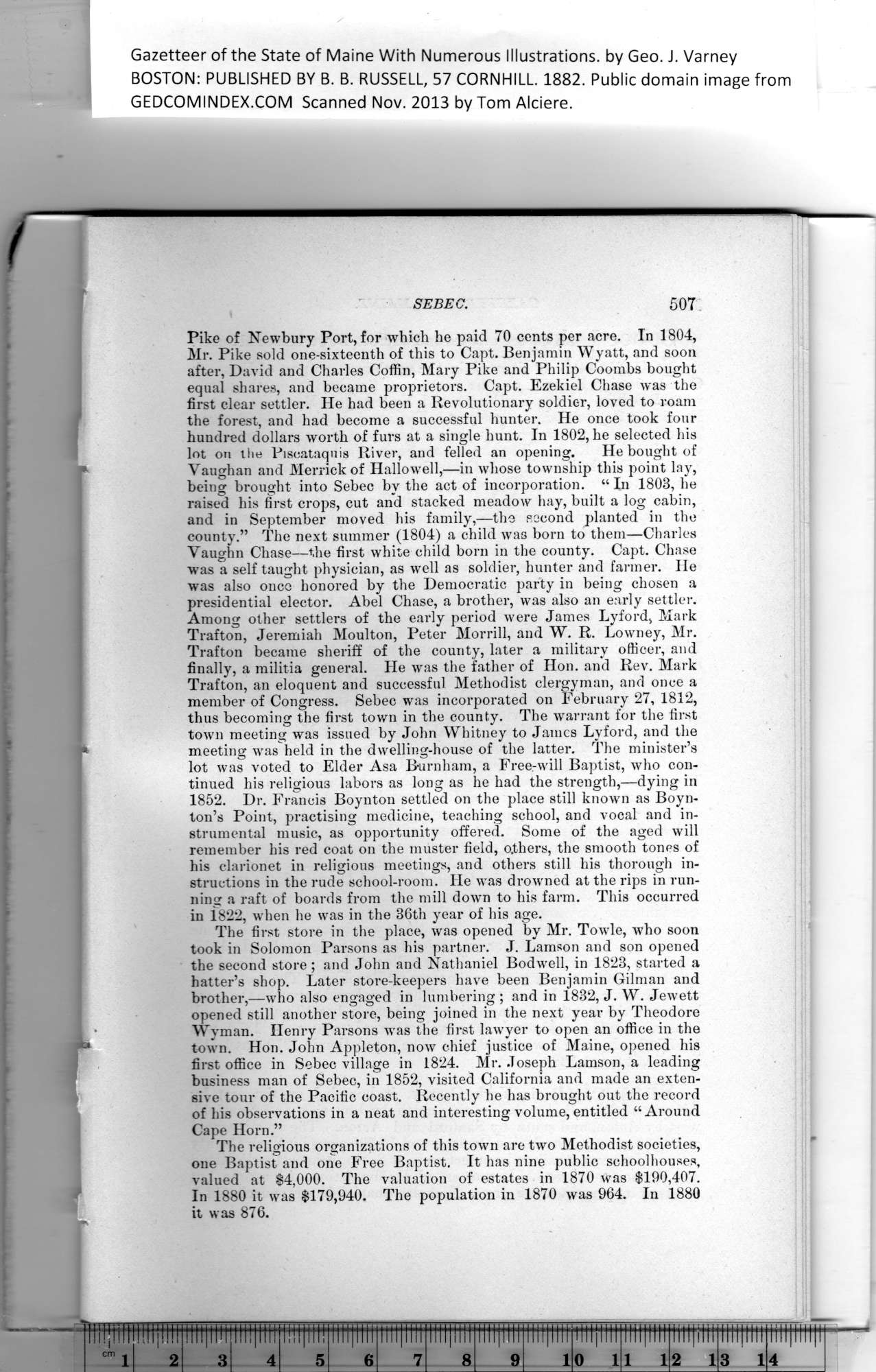|
Gazetteer of the State of Maine With Numerous Illustrations, by Geo. J. Varney
BOSTON: PUBLISHED BY B. B. RUSSELL, 57 CORNHILL. 1882. Public domain image from
SEBEC. 507
Pike of Newbury Port, for which he paid 70 cents per acre. In 1804,
Mr. Pike sold one-sixteenth of this to Capt. Benjamin Wyatt, and soon
after, David and Charles Coflin, Mary Pike and Philip Coombs bought
equal shares, and became proprietors. Capt. Ezekiel Chase was-the
first clear settler. He had been a Revolutionary soldier, loved to roam
the forest, and had become a successful hunter. He once took four
hundred dollars worth of furs at a single hunt. In 1802, he selected his
lot on the Piscataquis River, and felled an opening. He bought of
Vaughan and Merrick of Hallowell,—in whose township this point lay,
being brought into Sebec hy the act of incorporation. “ In 1803, he
raised his first crops, cut and stacked meadow hay, built a log cabin,
and in September moved his family,—the second planted in the
county.” The next summer (1804) a child was born to them—Charles
Vaughn Chase—the first white child born in the county. Capt. Chase
was a self taught physician, as well as soldier, hunter and farmer. He
was also once honored by the Democratic party in being chosen a
presidential elector. Abel Chase, a brother, was also an early settler.
Among other settlers of the early period were James Lyford, Mark
Trafton, Jeremiah Moulton, Peter Morrill, and W. R. Lowney, Mr.
Trafton became sheriff of the county, later a military officer, and
finally, a militia general. He was the father of Hon. and Rev. Mark
Trafton, an eloquent and successful Methodist clergyman, and once a
member of Congress. Sebec was incorporated on February 27, 1812,
thus becoming the first town in the county. The warrant for the first
town meeting was issued by John Whitney to James Lyford, and the
meeting was held in the dwelling-house of the latter. The minister’s
lot was voted to Elder Asa Burnham, a Free-will Baptist, who con-
tinued his religious labors as long as he had the strength,—dying in
1852. Dr. Francis Boynton settled on the place still known as Boyn-
ton’s Point, practising medicine, teaching school, and vocal and in-
strumental music, as opportunity offered. Some of the aged will
remember his red coat on the muster field, o.thers, the smooth tones of
his clarionet in religious meetings, and others still his thorough in-
structions in the rude school-room. He was drowned at the rips in run-
ning a raft of boards from the mill down to his farm. This occurred
in 1822, when he was in the 36th year of his age.
The first store in the place, was opened by Mr. Towle, who soon
took in Solomon Parsons as his partner. J. Lamson and son opened
the second store ; and John and Nathaniel Bodwell, in 1823, started a
hatter’s shop. Later store-keepers have been Benjamin Gilman and
brother,—who also engaged in lumbering; and in 1832, J. W. Jewett
opened still another store, being joined in the next year by Theodore
W yman. Henry Parsons was the first lawyer to open an office in the
t ^ town. Hon. John Appleton, now chief justice of Maine, opened bis
I first office in Sebec village in 1824. Mr. Joseph Lamson, a leading
^ business man of Sebec, in 1852, visited California and made an exten-
sive tour of the Pacific coast. Recently he has brought out tbe record
of Ids observations in a neat and interesting volume, entitled “Around
Cape Horn.”
The religious organizations of this town are two Methodist societies,
one Baptist and one Free Baptist. It has nine public schoolhouses,
valued at $4,000. The valuation of estates in 1870 was $190,407.
In 1880 it was $179,940. The population in 1870 was 964. In 1880
it was 876.
PREVIOUS PAGE ... NEXT PAGE
This page was written in HTML using a program written in Python 3.2
|
